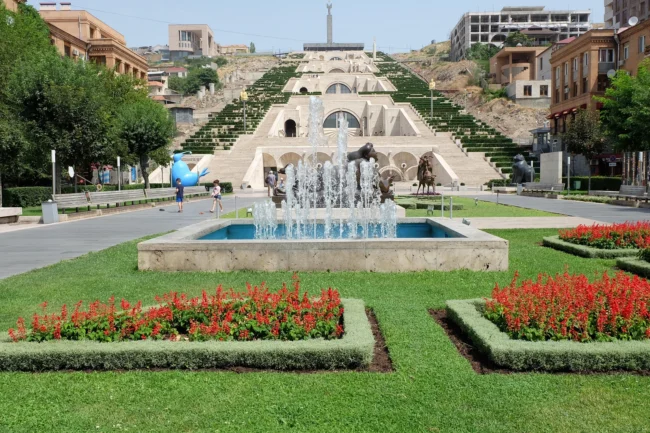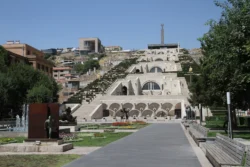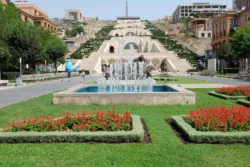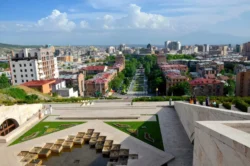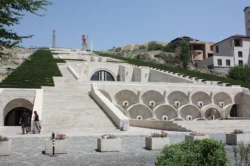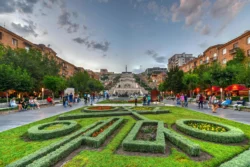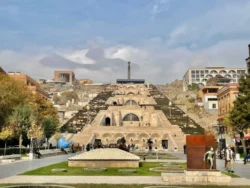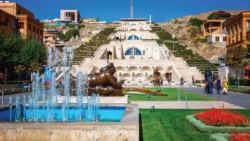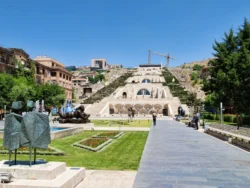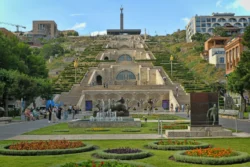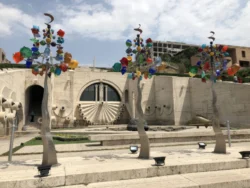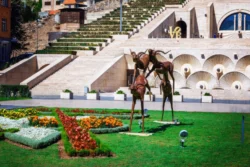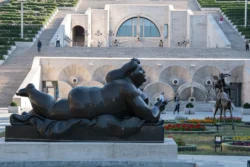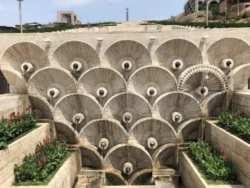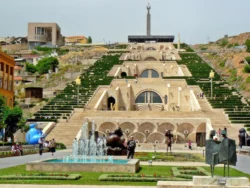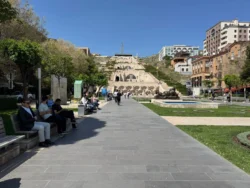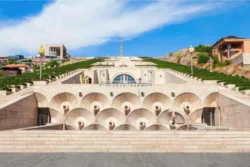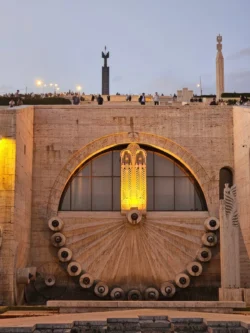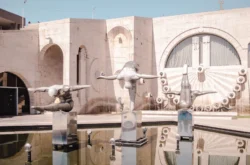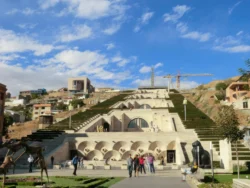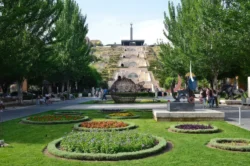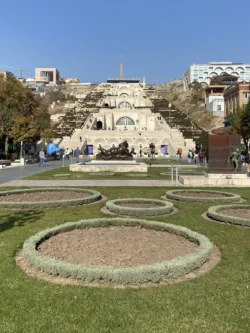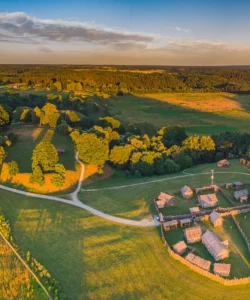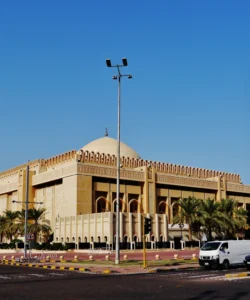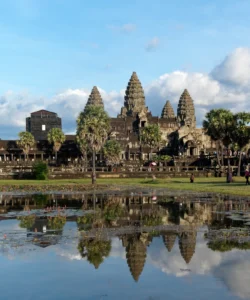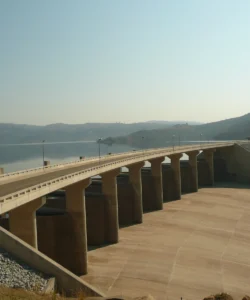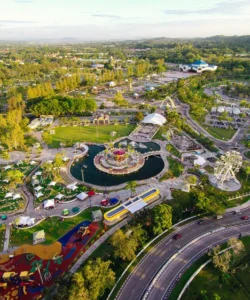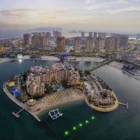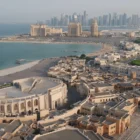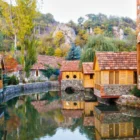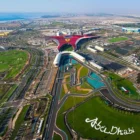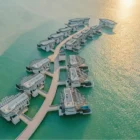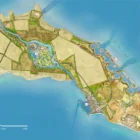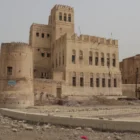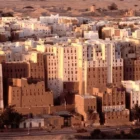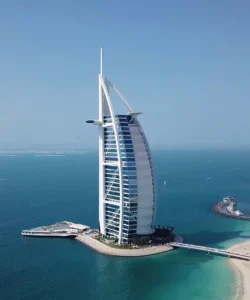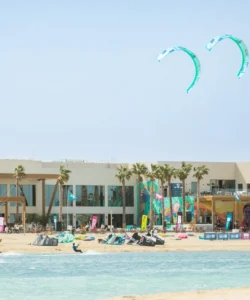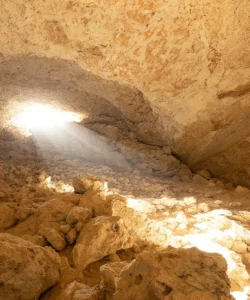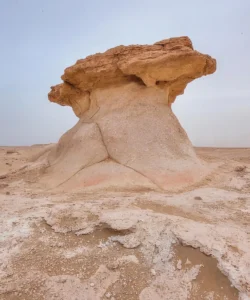The Cascade Complex (Armenian: Կասկադ, Kasakd) is a monumental building complex in Yerevan, Armenia, renowned for its terraced gardens, extensive staircases, and contemporary art installations. It serves as a vibrant cultural hub and offers breathtaking panoramic views of the city and Mount Ararat.
Listen to an introduction about Cascade Complex
Name and Address
- Name: Cascade Complex (also known simply as “The Cascade” or “Yerevan Cascade”). It also houses the Cafesjian Center for the Arts.
- Address: 10 Tamanyan St, Yerevan 0009, Armenia.
- Location: Situated in the northern part of Yerevan’s city center, near the Opera House and Matenadaran. It visually connects the city center with Victory Park, which sits atop the hill.
How to Get There
The Cascade Complex is a central and easily accessible attraction in Yerevan:
- By Metro: The nearest metro stations are Yeritasardakan and Marshal Baghramyan. From either station, it’s a short walk or a quick taxi/bus ride to the Cascade.
- By Public Transport: Various city buses and minibuses (marshrutkas) have routes that pass through or near the complex. Look for routes along Tamanyan Street or those with stops near the Opera House.
- By Taxi or Ride-Sharing: Taxis and ride-sharing services (like Yandex.Taxi or GG Taxi) are readily available and can drop you directly at the base of the Cascade. The ride from central Yerevan is typically very short (around 2-5 minutes).
- Walking: The Cascade is a popular walking destination from many central Yerevan locations, including Republic Square (about a 15-20 minute walk).
- Accessibility: While the exterior features many steps (572 in total), there are indoor escalators that operate daily from 8:00 AM to 8:00 PM, making the ascent accessible to all visitors and allowing you to view the interior art galleries. After 8 PM, access is only by foot.
Landscape and Architecture
The Cascade Complex is a remarkable fusion of urban planning, monumental architecture, and public art, designed to integrate Yerevan’s varying elevations.
- Design Concept: Originally conceived by architect Alexander Tamanyan in the 1920s to connect the northern and central parts of the city with cascading gardens and waterfalls, the project was reinterpreted and largely built in the 1970s and 80s by architects Jim Torosyan, Aslan Mkhitaryan, and Sargis Gurzadyan. Its revitalization and completion in the 2000s were largely supported by philanthropist Gerard Cafesjian.
- Terraced Structure: The complex is a massive stairway made of white travertine stone, consisting of five hillside terraces connected by 572 steps. It ascends a 15-degree slope, spanning 302 meters (991 ft) in length and 50 meters (164 ft) in width.
- Cafesjian Center for the Arts: Integrated within the Cascade’s interior are exhibition halls and galleries that form the Cafesjian Center for the Arts, showcasing a rich collection of contemporary art, including a significant glass collection.
- Sculpture Gardens: The exterior terraces and the gardens at the base (Cafesjian Sculpture Garden) are adorned with numerous sculptures and art installations by internationally renowned artists such as Fernando Botero, Lynn Chadwick, and Barry Flanagan, creating an open-air art promenade.
- Fountains: A series of cascading fountains flow down the center of the stairway, adding a refreshing visual and auditory element, especially on warm days.
- Panoramic Views: Each level offers increasingly spectacular panoramic views of Yerevan city, its pink tuff buildings, and on clear days, the majestic Mount Ararat in the distance.
- Materials and Style: The use of local tuff stone and a blend of classical Armenian architectural motifs with Soviet-era monumentalism gives the Cascade its distinctive appearance.
What Makes It Famous
The Cascade Complex is famous for being a unique blend of civic infrastructure, art museum, and public space:
- Iconic Landmark of Yerevan: It is one of the most recognizable symbols of Yerevan, a must-visit for both locals and tourists.
- Open-Air Art Museum: The integration of world-class contemporary sculptures and art installations throughout its outdoor and indoor spaces makes it a unique and accessible art experience.
- Panoramic City Views: It offers the best vantage points for sweeping views of Yerevan and the iconic Mount Ararat.
- Cultural Hub: The Cascade frequently hosts concerts, festivals, and public events on its steps, which double as an amphitheater, creating a vibrant atmosphere.
- Architectural Ambition: Its sheer scale and innovative design, connecting different parts of the city’s topography, represent a significant architectural achievement.
- Symbol of Resilience: Its history of construction, interrupted by the 1988 earthquake and the collapse of the Soviet Union, and subsequent revitalization, symbolizes Armenia’s perseverance.
Differences from Other Landmarks
The Cascade Complex distinguishes itself from other Armenian landmarks in several key ways:
- Urban Integration and Modernity: Unlike ancient monasteries (like Geghard, Tatev, Noravank) or historical fortresses (like Erebuni) that are often isolated or represent older eras, the Cascade is a modern (though with Soviet-era origins) urban landmark that is deeply integrated into the daily life of Yerevan, serving as a contemporary civic and cultural space.
- Art-Centric Focus: While other sites may have artistic elements (frescoes, carvings), the Cascade’s primary identity is as a public art museum and gallery, featuring modern and contemporary works, a distinct focus from the religious or historical narratives of traditional sites.
- Verticality and Accessibility: Its design as a massive terraced stairway with internal escalators provides a unique vertical ascent experience within a city, offering a different perspective compared to flat city squares (like Republic Square) or remote mountain sites (like Mount Aragats).
- Purpose: While historical sites often served religious, defensive, or administrative purposes, the Cascade was conceived as a grand urban connector and a cultural/recreational space, reflecting a more modern urban planning philosophy.
- Ongoing Evolution: Even today, discussions about its completion and modernization continue, highlighting its dynamic and evolving nature as a living landmark.
Cascade Complex Photos:
